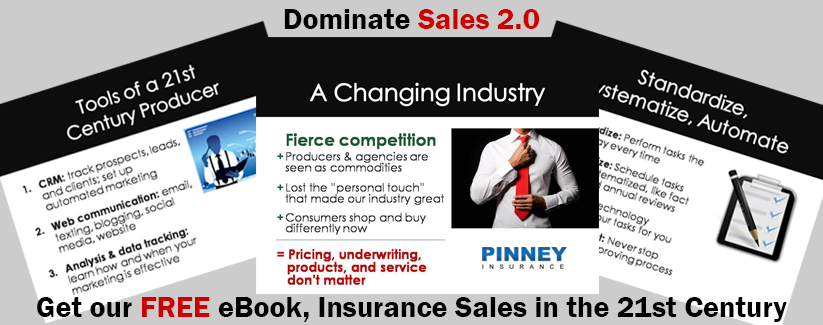
Recently, a Pinney Brokerage Director visited the Modern Life Insurance Selling Podcast, where the topic of discussion was overcoming objections when selling life insurance over the phone. If you've ever had trouble closing a sale over the phone, these suggestions can help.
Let's go through the top five most common objections, with a quick summary of the suggestions. If these sales strategies work for you, why not join the Pinney team? Call us at 1-800-823-4852 and ask to speak to a Brokerage Director, or click here to email our Brokerage Sales Support team.
Objection #1: "It's Too Expensive."
Your strategy: Don't make a call without knowing a prospect's income first—or try to find out quickly once the call begins. You can do this by asking the right questions during fact finding. Start by telling your prospect, "I want to customize a quote for you. To do that, I just need a few pieces of information: how much income you have, how many years left on your mortgage, the amount the mortgage is for, etc." You'll be able to tell quickly if price will be an issue.
If money is tight for your prospect, keep the focus away from price. For example, you could say, "What I have here is a customized approach for insuring you for as much is appropriate. That number is 1.2% of your monthly income, but what you're trading is the ability to sleep well at night, knowing your family will be all right if something happens to you—the mortgage will be paid off and they won't have to move because you provided a legacy for them from beyond the grave." Using a percentage is preferable to quoting a dollar amount for getting past this objection.
Objection #2: "I Need to Think about It."
Your strategy: Reframe your script so that this common objection is just one of several talking points you've already covered. Objections are really just the need for more information. They happen when your prospect doesn't know what to ask. Take "thinking about it" out of the equation. Life insurance is not a "think about it" decision.
You can always reframe the situation and put the burden back on the client. For example, you can highlight the urgency of the situation with a statement like this: "We never know when our time is up. That's not something we can predict. Do you think a guy who passes away without life insurance wishes he thought about it more? No. He wishes he did something about it." The goal of this reframe is to show a prospect the ramifications of "thinking about it."
There is no 'hard close.' Instead, every sales call should be a series of soft closes. Let the client close himself.
Objection #3: "I Need to Speak to My Spouse."
Your strategy: Address the objection and move right past it. If you let them keep talking about the objection, they'll get stuck there. Instead, make the objection a thing of the past. For example, if you're talking to a husband, you could say, "In all my years of doing this, I've never had a wife call me and say I sold her husband too much life insurance. Now, I've got her name listed as the beneficiary here, so what's her date of birth?" By moving right past the objection, you keep the process moving.
On the other hand, if you're speaking to a wife, you can use a more emotional strategy to get past this objection. For example, you could say, "Here's what the process looks like. Now, I don't want this to drag on for days for you. I only see my wife for three hours a day, and I know I don't want that time to be taken up talking about life insurance. Let's go ahead and complete the app now, and if anything changes in the next few weeks, you can call me." This gives your prospect time to discuss it at home (if they want), but it also gets the process started and moves them to the next step.
Objection #4: "I'm Just Shopping Around."
Using a script is crucial in order to have the same talking points and flow each time. 'Script' has become a dirty word, but you need it.
Your strategy: If you're going to hear this one, you want to hear it within 30 seconds. If you do, you know exactly how much work you have to do. Ideally, you want to hear this one after the introductory part of the call, just after introducing yourself, stating the purpose of the call, and verifying the information they submitted.
If you get hit with this objection later, tell your prospect you're a professional shopper. In this case, you're their personal shopper. If you're an independent agent, you can say, "I'm unbiased. I work with life insurance companies, not for life insurance companies." You can even use a tool like Join.me to share screen shots of quotes (with those familiar carrier logos) to make the client feel more at ease. We especially like using this tool with clients who have a single impairment. You can walk them through XRAE, and you'll both see the results at the same time. When the client sees what they want, you can move forward.
Objection #5: "I'm Not Interested."
Your strategy: Move right past this objection. The easiest way past it is to say something like, "Life insurance...who is interested? It's something you never want to use, but you have to have it." It's best not to pause and let the client talk here. When you do move on, try asking for a piece of data, something they can quickly and easily answer, such as beneficiary information or where they want the policy mailed. This redirects the conversation and gets you on to the next point.
If that feels pushy, just remember—you're not being pushy. You're trying to get to the next part of the conversation, where the things you say will probably change their mind.
Need help finding the right solutions for your clients? As the only full-service digital BGA, we'd love to help. Call us at 1-800-823-4852 and ask to speak to a Brokerage Director, or click here to email our Brokerage Sales Support team.

